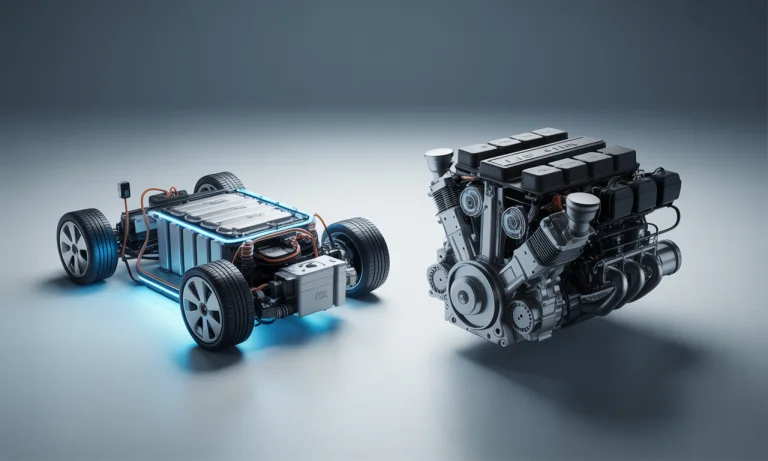City lights shimmer on the windshields of two neighboring cars—one humming silently, the other idling with a faint mechanical growl. On today’s roads, this encounter is no longer rare. The debate over electric versus combustion car engines has become dramatically relevant in 2025, as buyers weigh every nuance: environmental consequences, the joy of driving, economic logic, and the unseen intricacies beneath the hood. The choice isn’t just practical; it’s a statement. Tesla continues to fuel headlines, while giants like Ford, Chevrolet, Toyota, Nissan, BMW, Volkswagen, Hyundai, Honda, and Audi reshape their identity with each new electric model. Charging infrastructure races to catch up. Governments are rolling out fresh incentives. In this comparative chronicle, we examine the evolving persona of cars—mechanical versus electric—through real-life experiences, stories from the roadside, and the silent revolution happening in garages everywhere. The future, it seems, is not simply about horsepower, but about purpose, progress, and priorities behind every ignition.
Comparing Electric and Combustion Car Engines: Efficiency, Power, and Ownership
When Eric, a long-time Toyota loyalist, pulled into work with his first Hyundai EV, coworkers gathered around, intrigued. The switch wasn’t just about technology; it was about the numbers. Electric motors transform roughly 85-90% of battery energy into motion, while combustion engines convert only about 20-30%—the rest disappears as heat. That means, for every journey, the electric car demands less energy from its source, translating to fewer stops and a different rhythm on daily commutes. The Chevrolet that once consumed three gallons of gas now has an electric rival cruising the same distance at a fraction of the cost—and carbon output. But beneath these statistics lies another gap: EVs accelerate instantly, their torque immediate, responding to a tap rather than a crescendo of revs. Combustion cars, in contrast, create a symphony of gears and controlled explosions, drawing nostalgia for many. Both camps see their maintenance costs evolve: engines with hundreds of moving parts versus a simplified electric drivetrain challenging even seasoned mechanics, an evolution that’s often underestimated by those new to EVs. More on personal experiences of switching—you’ll find some essential points in this real-world test drive.
Powertrain Differences: Real-World Impacts on Driving and Maintenance
Alison, a rideshare driver in Los Angeles, once prided herself on rapid refueling stops and long hauls in her Honda sedan. Since transitioning to an EV, she notes her world has changed: maintenance appointments have become rare, and her vehicle’s range—though slightly less than her combustion car—covers her entire shift on a single charge. Electric cars like the Volkswagen ID.4 or Audi e-tron have no need for oil changes, exhaust repairs, or frequent brake replacements thanks to regenerative braking. Yet, range and refueling anxiety remain, with rapid chargers still catching up to the ubiquity of gas stations. In the city, she can plug in at home or work, but on the open highway, planning becomes strategic. If you’re curious about managing this shift and new ownership realities, this maintenance cost comparison unpacks it further.
| Feature | Combustion Engine | Electric Motor |
|---|---|---|
| Energy Efficiency | 20-30% | 85-90% |
| Torque Delivery | Progressive, builds with RPM | Instant, available from stop |
| Maintenance Needs | High (oil, filters, exhaust) | Low (fewer moving parts) |
| Refueling/Charging Time | 3-5 min at pump | 30 min to several hours |
| Range | 300-500 miles typical | 200-350 miles average |
Environmental Footprints: Emissions, Electricity, and the Hidden Cost of Batteries
Sarah, an engineer at BMW, often finds herself debating with her uncle, a lifelong Ford mechanic. She points to emissions data: combustion engines leave a clear trail of CO2, nitrogen oxides, and particulates, the legacy of fuel burned. Electric cars, conversely, are silent on the road—but their impact is linked to the power plants behind the plug. New research for 2025 consistently places EVs ahead, particularly where grids draw from renewables. However, skeptics note that the birth and death of each EV—especially batteries—carry environmental weight. Mining lithium, cobalt, and nickel for batteries, as well as disposal, are nontrivial. Ford’s latest initiatives in recycling and Volkswagen’s investment in battery innovation show the industry’s shifting priorities. Meanwhile, real-world studies, including battery innovation overviews, reveal a steady decline in lifecycle emissions as recycling improves and renewable energy expands. For city dwellers, the clean local air and absence of idling headaches have become palpable benefits—ask any urban Nissan Leaf driver or the next Hyundai Ioniq parked nearby.
Energy Sources: How the Grid Shapes the Green Credentials of EVs
While some BMW owners meticulously track their carbon footprint, others, like the suburban Audi family, focus simply on convenience. Yet both groups benefit the most where electricity is sourced sustainably. The growing share of solar, wind, and hydroelectric in the global mix is reducing the “indirect” emissions of EVs. Meanwhile, hybrid solutions have emerged—for more on how these fit into the landscape, take a look at this hybrid vs. traditional comparison. These nuances keep the environmental debate from ever being truly simple—prompting both sides to keep asking: what’s under the hood, and what’s behind the plug?
| Impact Category | Combustion Engine | Electric Car |
|---|---|---|
| Tailpipe Emissions (driving) | High (CO2, NOx, particulates) | Zero |
| Indirect Emissions | None | Varies by electricity source |
| Manufacturing Impact | Moderate (engine, components) | High (battery materials) |
| Recycling/EOL Impact | Lower, established | Improving (battery recycling) |
Cost Analysis: Upfront Price, Running Costs, and Incentives in 2025
Pricing drama plays out at every dealership. Ford and Nissan dealerships parade their hybrid and combustion models with competitive discounts. Tesla beckons with futuristic features—and a higher sticker price. Yet, once the ink dries, the equation evolves. Owners quickly find electric cars cost less to run, especially with incentives that trim purchase prices or offer perks like HOV lane access. Electricity is usually cheaper per mile than gasoline, even as battery production costs—about a third of an EV’s total price—remain high. Maintenance is another domain where drivers save: no more oil changes for the Honda EV crowd, and extended brake pad life thanks to regenerative systems in models from Audi to Volkswagen. Still, some buyers fret about battery longevity, even as warranties become more generous and cell technology steadily advances. The big bottom line? After five years and 75,000 km, electric cars like Hyundai’s and Nissan’s latest models generally come out ahead—especially for those racking up high mileage or benefiting from generous incentives. Dive deeper into the details in this cost comparison guide.
Long-Term Savings and Government Policy: How Incentives Tip the Balance
Melissa, a Volkswagen enthusiast, was swayed by rebate announcements. Federal and state programs tipped the scales in favor of her new EV. The calculus changed: after-tax incentives, her monthly payments went down compared to her previous combustion-powered Chevrolet. She found other hidden perks—like free municipal parking and discounted tolls—featured in this battery innovation report and further dissected in this incentives breakdown. The lesson for would-be buyers: read the fine print, as every region rewrites its playbook in favor of electrification.
Infrastructure and Lifestyle: Charging, Commuting, and the Road Ahead
Doug, an early Nissan Leaf adopter, values the freedom of charging at home during quiet nights. Yet, when he plans a cross-country trip, he still must map out charging stops—sometimes in scenic but remote rest areas. The pace of charging infrastructure is closing this gap, with ultrafast stations pioneered by Tesla and partnerships between giants like BMW and Ford on the rise. City commuters in particular are embracing the convenience: home charging and expanding workplace options are transforming the daily experience. But for those venturing off the grid, careful planning is crucial and occasionally stressful. If city life is your reality, discover more in this guide to urban electric commuting. For adventurers, check these road trip strategies for EVs.
Future Trends: How Automakers and Policy Makers Shape the Next Decade
By now, even legacy brands like Chevrolet and Honda are mapping all-electric futures. The momentum will only accelerate as cities tighten emissions regulations and automakers introduce battery breakthroughs. The endgame? A steady, inevitable move toward electrification, with all-new engine tech and digital features transforming every commute. As for combustion engines, they’re not going to disappear overnight. Market realities, rural needs, and worldwide infrastructure mean gasoline vehicles will be part of the landscape for years—just more a emblem of history than the horizon. For next-level innovations, see tech advances and projections from autonomous driving experts.
Summary Table: Electric vs. Combustion Cars Comparison 2025
| Aspect | Electric Car | Combustion Car |
|---|---|---|
| Energy Efficiency | Very High (85-90%) | Low (20-30%) |
| Local Emissions | Zero | CO2, NOx, particulates |
| Purchase Price | Higher initially | Lower initially |
| Running Costs | Low (electricity, maintenance) | High (fuel, maintenance) |
| Government Incentives | Common and increasing | Rare |
| Driving Experience | Instant torque, quiet | Traditional powerband, engine noise |
| Charging/Refueling | Takes longer (charge time) | Quick (gas tank fill) |
| Range | Improving, still catching up | Long-established |
FAQ: Electric vs. Combustion Car Engines
Are electric cars truly better for the environment overall?
Generally, yes—especially when charged with renewable electricity. Although manufacturing and battery recycling have their own impacts, lifecycle studies indicate EVs leave a considerably lower carbon footprint, especially as more grids go green. For more, visit this benefits overview.
Is the higher upfront price of an electric car offset over time?
In most high-mileage or urban usage cases, yes. Lower fuel and maintenance costs, combined with regional incentives, typically balance or exceed the initial price difference within five years. Explore ownership dynamics in this TCO report.
How far can an electric car go on a single charge?
Ranges in 2025 typically run from 200 to 350 miles, depending on model and use conditions. Some high-end models can exceed 400 miles, and public charging support is steadily improving. Curious how far you’ll go? Get the latest at this range analysis.
What if I have to take long road trips?
It’s possible with EVs—especially Tesla, BMW, and Hyundai—but requires planning to work around charging station locations and charge times. For detailed planning advice, see these long-trip tips.
Which brands are leading the electric revolution?
Tesla set the pace, but Ford, Chevrolet, Toyota, Nissan, BMW, Volkswagen, Hyundai, Honda, and Audi have all committed to broad line-ups—often blending advanced safety and connected tech, as seen in emerging tech guides.
Did you like it? 4.5/5 (22)






